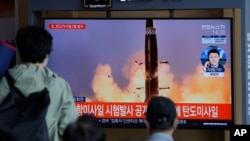North Korea said the ballistic missiles it launched Wednesday were fired from a train, the first time the nuclear-armed country has tested a railway-based launch system.
Wednesday’s launch is North Korea’s second in less than a week, as it increases pressure on the United States over stalled nuclear talks.
Pictures posted in state media Thursday showed a dark green missile emerging from a railcar parked near a tunnel in a mountainous area, which was filled with orange plumes of smoke and fire from the launch.
The drill, which involved North Korea’s Railway Mobile Missile Regiment, is part of a wider effort to enable the country to strike an “intensive blow to the menacing forces in many places at the same time,” according to the Korean Central News Agency.
The train-based launch gives North Korea yet another option for launching and protecting its rapidly expanding missile arsenal.
North Korea has been pushing hard to develop more ways to launch missiles, whether from the sea, roads, or, now, railways. Analysts say the multipronged strategy is meant to make it more difficult for U.S. and other intelligence agencies to monitor, predict, and detect North Korean launches.
“They’re trying everything they can think of,” Joshua Pollack, a researcher at the James Martin Center for Nonproliferation Studies, told VOA.
“It’s just one more set of problems for the enemy,” he said.
North Korea has long test-fired missiles using a variety of road-mobile launch vehicles, which provide more of an element of surprise than do firings from its formal launch facilities.
The North has also unveiled a series of submarine-launched ballistic missiles. Although it does not currently have a submarine capable of deploying such missiles, Pyongyang in 2019 offered its first glimpse of what appeared to be such a vessel under construction.
North Korea's strategy
With its latest train-based launch system, North Korea appears to be pursuing a relatively cheap and reliable way to rapidly transport a small number of missiles in ways that are difficult to detect, said Adam Mount, a senior fellow at the Federation of American Scientists.
“Russia did it. The U.S. considered it. It makes a ton of sense for North Korea,” Mount said on Twitter.
There are drawbacks to such a strategy. North Korea’s rail system is relatively small, old, and in bad shape.
“In a crisis, U.S. intelligence will be capable of monitoring this rail network closely to determine its status, chart the movement of trains, and try to distinguish between decoy trains and ones that are nuclear armed,” Mount said.

There are similar limitations with North Korea’s other launch systems.
Many of North Korea’s road-mobile launchers are massive, featuring as many as 22 wheels. That makes them difficult to maneuver, especially on North Korean roads, many of which are in poor condition.
While submarine-launched ballistic missiles would provide North Korea with an unpredictable new capability, some analysts say the threat is exaggerated. That is in part because North Korea apparently has yet to finish building, much less deploy, a single submarine capable of firing the missiles. The vessel being built, some analysts say, appears outdated.
Although each launch system has its own vulnerabilities, analysts say the North’s approach looks more dangerous when considered as a whole.
By diversifying its launch systems, North Korea is “compounding the demands on a finite number of U.S. sensors,” Mount said.
It is not clear whether or when North Korea will deploy its new launch systems, such as the ballistic missile submarine or the train-based launch system. However, it may feel more motivation to do so, as South Korea continues to unveil new weapons.
On Wednesday — the same day as the North’s ballistic missile launch — South Korea announced it conducted its first underwater test of a submarine-launched ballistic missile. The test makes South Korea only the seventh country with a homegrown one.
South Korean President Moon Jae-in, who observed the launch, said his country’s upgraded missile capabilities can be a “sure-fire deterrent to North Korea’s provocation.”
Kim Yo Jong, the politically powerful sister of North Korean leader Kim Jong Un, blasted Moon’s remarks. North Korea’s launches, she insisted, were not a “provocation,” but “part of a normal and self-defensive action.”
North Korea has repeatedly cited the South Korean military buildup, as well as the presence of U.S. troops, as justification for its own weapons advancement.




